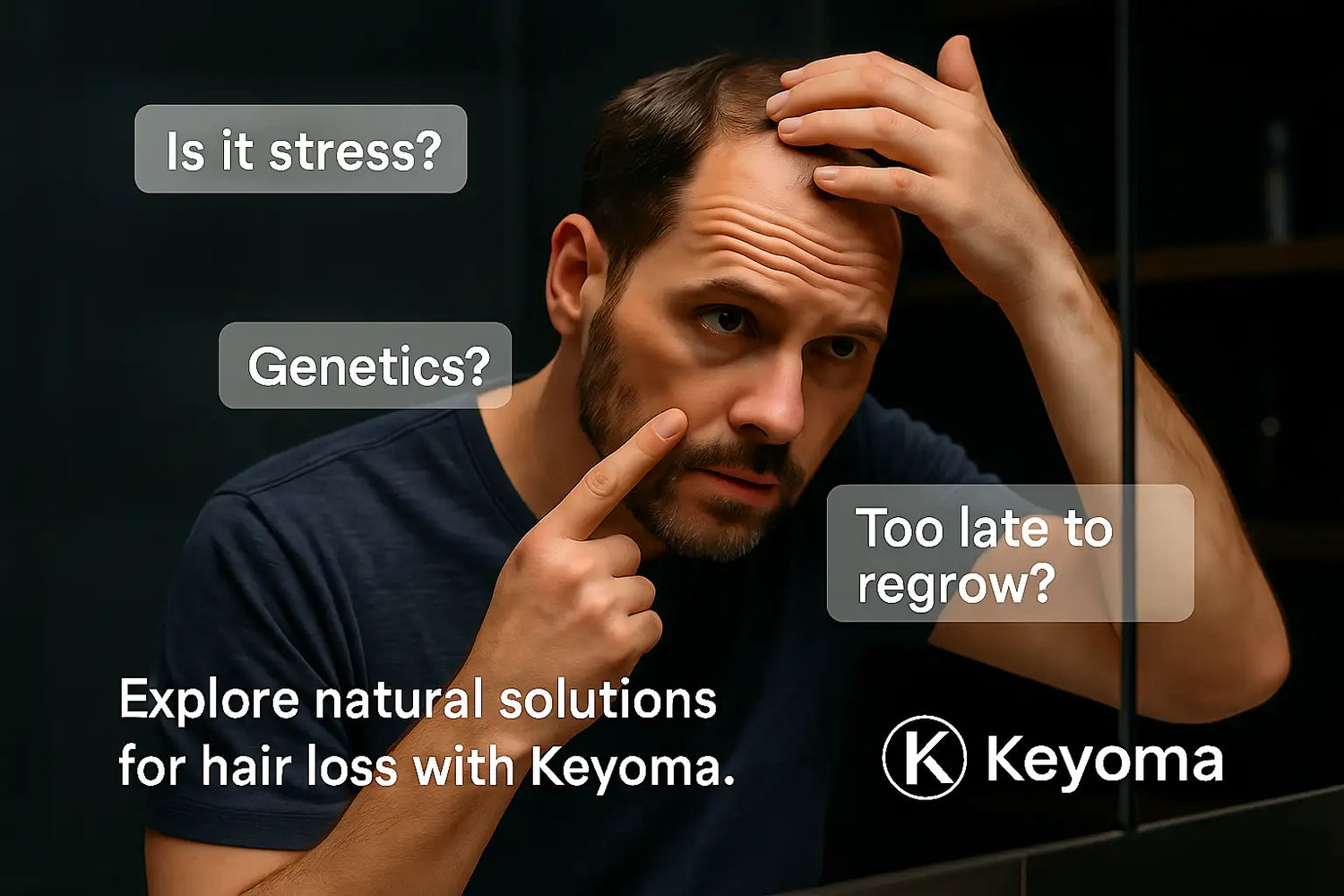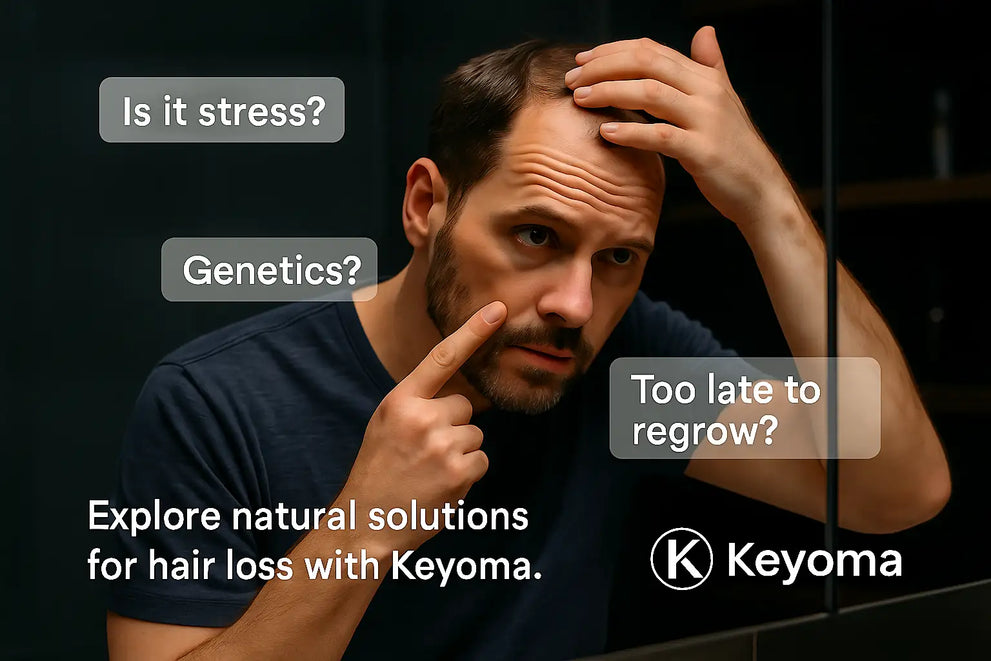Hair loss is a common issue that affects many men over 50, but it can also impact those in their 20s, 30s, and 40s. We’ve put together an illustration highlighting 7 possible causes of male hair loss.
If you’re starting to notice thinning or shedding and want to understand what’s behind it, scroll down to learn more. Visit our hair loss clinic to explore your options and take the next step toward healthier hair.
1. Genetic Hair Loss (Male Pattern Baldness)
This type of hair loss affects both men and women and is the most common form worldwide. In men, it’s known as male pattern baldness; in women, it’s called female pattern hair loss. The medical name for both is androgenic alopecia.
This condition happens when you inherit genes that cause your hair follicles—the structures where hair grows—to gradually shrink. Over time, these follicles produce thinner strands and eventually stop growing hair altogether. While the process can start as early as the teenage years, it typically begins later in adulthood.
Treatment can help slow down or even stop the hair loss. In many cases, it may encourage regrowth. Starting treatment early increases the chances of success. Without intervention, the hair loss will likely continue to progress.
2. Hair Loss in Men Over 50
As people get older, hair growth naturally slows down, leading to noticeable thinning. Over time, some follicles stop producing new strands altogether, causing overall hair density to decrease.
Hair may also begin to lose its pigment, turning gray or white. In women, the hairline can gradually move back as part of the aging process. If detected early, treatment can help some individuals regrow hair and slow further loss.
3. Autoimmune Hair Loss (Alopecia Areata)
Alopecia areata is an autoimmune condition where the body’s immune system mistakenly attacks the hair follicles—the structures that anchor each strand—leading to hair loss.
This can happen anywhere on the body, including the scalp, eyebrows, eyelashes, inside the nose, or in the ears.
In some cases, the hair may regrow on its own. If it doesn’t, treatment options are available to help encourage new growth.
4. Cancer Treatments Like Chemo or Radiation
If you undergo chemotherapy or receive radiation therapy to the head or neck, you may experience significant hair loss within a few weeks of starting treatment. In many cases, this includes most or all of the hair in the treated area.
Hair typically begins to grow back a few months after treatment ends. A dermatologist may recommend medications to help speed up the regrowth process.
5. Hair Loss From Illness, Fever, or Physical Stress
Recovering from a medical condition, or undergoing surgery, you might start to notice more hair falling out than usual—on your pillow, in your brush, or in the shower. This type of shedding can also follow emotional stress, such as going through a divorce or losing a loved one.
Once the stress passes, your body typically resets, and the excessive hair loss slows down. Most people see their hair return to its usual thickness within 6 to 9 months.
6. Harsh Hair Care Routines
Frequent use of hair dyes, perms, or chemical relaxers can weaken and damage your strands over time. This repeated damage may eventually lead to hair loss.
Adjusting your hair care habits can help prevent further loss. However, once a hair follicle becomes severely damaged, it can no longer produce new hair. If enough follicles are harmed, this can result in permanent bald patches.
7. Hairstyles That Cause Scalp Tension
Wearing your hair in tight styles like braids, ponytails, or buns on a regular basis can put constant stress on the roots, eventually leading to permanent hair loss. This condition is known as traction alopecia.
Can the hair grow back? Unfortunately, no—once the follicles are permanently damaged, regrowth is unlikely. However, you can prevent further loss by loosening your hairstyles and reducing tension on your scalp.
8. DHT and Testosterone-Related Hair Loss
One frequent cause of hormonal imbalance is polycystic ovary syndrome (PCOS), a condition that causes cysts to form on the ovaries and may lead to various symptoms, including hair loss.
Discontinuing certain types of birth control pills can also trigger a temporary shift in hormone levels. When hormone imbalances occur, women may experience thinning hair or noticeable shedding on the scalp.
9. Hair Loss From Scalp Infections
A scalp infection can cause scaly, irritated patches on the scalp. You might notice tiny black dots, which are actually broken hair stubs. In some cases, the infection leads to a bald patch.
With proper treatment, the infection can be cleared. Once it heals, hair usually begins to grow back in the affected area.
10. Hair Loss as a Side Effect of Medication
Hair loss can be a side effect of certain medications. If you suspect your medication is causing shedding, speak with the doctor who prescribed it to confirm whether hair loss is a known reaction.
Do not stop taking the medication on your own. Some prescriptions can cause serious health issues if stopped suddenly, so always consult your doctor before making any changes.
11. Can Scalp Psoriasis Lead to Hair Loss?
Many individuals with plaque psoriasis eventually experience flare-ups on their scalp, which can lead to temporary hair loss. While hair often grows back after the scalp clears, the process can take time.
Following dermatologist-recommended care tips can help manage symptoms and may reduce the risk of further hair loss.
12. Trichotillomania: Hair Pulling in Men
Some individuals repeatedly pull out their hair, often as a way to cope with stress or anxiety. In many cases, they may not even realize they’re doing it. This condition is called trichotillomania.
If the hair follicles remain intact, regrowth is possible. To allow the hair to grow back, it’s essential to stop the pulling behavior.
13. Scarring Alopecia and Permanent Loss
This condition occurs when inflammation permanently damages and destroys hair follicles. Once a follicle is destroyed, it loses the ability to produce new hair. A range of underlying disorders can lead to this, and the medical term for the group is cicatricial alopecia.
Hair cannot regrow from damaged follicles, but identifying and treating the condition early can help stop additional hair loss.
14. Hair Loss Caused by Certain STIs
If left untreated, a sexually transmitted infection (STI) can result in hair loss. Syphilis is one example—it can cause patchy hair thinning on the scalp, eyebrows, beard, and other areas. Other STIs may also lead to similar symptoms. Once the STI is properly treated, hair usually begins to grow back over time.
15. Thyroid Problems That Trigger Hair Loss in Men
If you have a thyroid disorder, you might notice your hair thinning or falling out in clumps when brushing. Thyroid imbalances can disrupt the hair growth cycle. By treating the thyroid condition, you can often stop the shedding and encourage your hair to grow back.
16. Hair Loss From Low Nutrients
If your body lacks certain essential nutrients, you may experience visible hair loss. Once you restore those missing vitamins or minerals through diet or supplements, hair often begins to grow back.
17. Friction From Helmets, Hats, or Pillowcases
Hair loss can occur in areas where boots, socks, or tight clothing repeatedly rub against the skin. This condition is called frictional alopecia. Once the friction stops, hair usually grows back naturally over time.
18. Exposure to Chemicals or Toxins
Exposure to toxic substances can cause gradual hair loss. Poisons such as arsenic, thallium, mercury, and lithium are known to trigger shedding. Ingesting a high dose of warfarin, commonly found in rat poison, can have the same effect.
Overconsuming certain nutrients like vitamin A or selenium can also become toxic and lead to hair loss. Once the exposure to the harmful substance stops, hair often begins to grow back.
Take Action on Male Hair Loss With Keyoma’s Natural Treatments
Preventing hair loss long-term depends on identifying and addressing the root cause. In general, the earlier you begin treatment, the better your chances of slowing down or reversing the process.
Even if your hair loss is genetic, treatments are available that can help reduce thinning or encourage regrowth. Whenever possible, speak with your doctor to discuss your concerns and rule out any underlying health issues that may be contributing to the problem.


